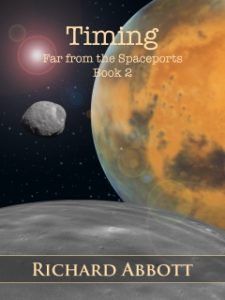
Many years ago I read a short science fiction story by Isaac Asimov called The Martian Way, which he published in 1952. In this, planet Earth maintained control over ambitious colonies elsewhere in the solar system by means of controlling the water supply. At the start of the story everyone assumed that Earth’s vast oceans were the only source of water available. Whoever controlled the water was in charge. The plot is resolved by the retrieval of a piece of Saturn’s rings the size of a small mountain, made largely of ice. With some modest engineering work this was propelled back to Mars where it was needed. The possibility of autocratic rule based on control of the necessities of life was gone.

It was a good story, and highlights our changing comprehension of the place of water in the universe at large. Go back only a century or two, and there was a widespread assumption that whatever other worlds might exist would be pretty much like Earth. Features on the Moon were called seas, bays, lakes and marshes, presuming that they held open water. Early science fiction writers like Jules Verne (From the Earth to the Moon and Around the Moon) and HG Wells (The War of the Worlds and The First Men in the Moon) took for granted that interplanetary travel would be relatively easy, and that once you landed, you would need no special protection except against low temperatures comparable to the Arctic. When in 1877 Italian astronomer Giovanni Schiaparelli named features on Mars canali (the Italian word for ‘channels’), nobody hesitated to use the English word canal.

Then came the early days of space travel, along with a dramatic increase in the power and accuracy of telescopes. The lunar seas turned out to be open plains with no running water at all. The surface features on Mars ceased to be seen as artificial water channels, and were reinterpreted as the result of natural weathering on dry rock. The language we used for the planets changed. In 1961, Arthur C Clarke wrote A Fall of Moondust, where the plot hinged on the total absence of water. In 1969, Buzz Aldrin referred to the “Magnificent Desolation” that he saw on stepping out of the Apollo 11 lunar module. Imagery from the Apollo missions – and the personal accounts of astronauts – established the idea in the popular consciousness that the vivid blue of Earth’s oceans was something unique and precious in a starkly barren universe. The image was reinforced by the “Blue Dot” picture taken from the Voyager I probe.

But after that, there was another wave of observations and information. Perhaps water was not so rare after all. The first target was the Moon, and a careful study of places which are permanently shadowed regions. It turned out that ice will tend to aggregate anywhere which is in shadow most of the time. Buzz Aldrin, turning to fiction in Encounter with Tiber, positioned an early lunar settlement at the Moon’s south pole, specifically because of this new-found source of water. The search for ice spread wider, and now it seems that pretty much everywhere we look we find it.
The asteroids have significant amounts scattered here and there, with some impressive finds by NASA’s Dawn probe. Mars itself shows every sign that open stretches of water once shaped the terrain, though accessing it nowadays might be tricky. As I was writing this, NASA reported the discovery of an underground body of ice just under the Martian surface. It seems that Asimov’s water-seeking Martian settlers would not have needed to trek out to Saturn after all. If they did go there anyway, they would find no mile-high ice mountains since the rings are largely made of tiny granules. However, several moons of both Jupiter and Saturn apparently have ice as their surface crust, and liquid water below.

So wherever we look in the solar system we find water, usually in the form of ice. Tomorrow’s space travellers and colonists will not have to worry about having access to water, though they will have to construct specialised equipment to access it. In Far from the Spaceports and Timing, my own fictional inhabitants of the Scilly Isles, somewhere out in the asteroid belt between Mars and Jupiter, will have to import many of life’s necessities, but not water – they will be able to find their own local supply.
Asimov wrote The Martian Way just as our scientific understanding was changing – indeed as with some other things he was ahead of his time. Although some of the details of his account would need updating, the basic theme remains sound. If and when we spread around the solar system, finding water is not going to be a problem.


Hi Richard,
Being retired from a federal water infrastructure agency (we built dams and canals throughout the western United States, I especially enjoyed this post. It’s true – water is the new oil and will be what everyone fights over in the future. At least you are offering hope that there is a supply out there somewhere!